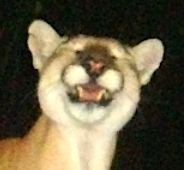Mystery Tracks
-
Uncle Rico

- Posts: 1480
- Joined: Thu Mar 20, 2008 7:48 pm
Saw these tracks yesterday and can't find any match that makes sense. The size, no fifth digit, and a lack of accompanying front and/or rear tracks is throwing me. Anyone want to take a swing at this? A friend of mine that works for the Utah Division of Wildlife Resources believes its a chupacabra.
-
cougarmagic

- Posts: 1410
- Joined: Wed May 07, 2008 5:21 pm
Those are quite weird.
Four -toed raccoon on steroids is all I can come up with. I checked on badger tracks, and it isn't that for sure.
Or possum on hard packed enough soil that the fifth digit isn't showing? I'll post this on a tracking forum and let everyone geek out about it.
Four -toed raccoon on steroids is all I can come up with. I checked on badger tracks, and it isn't that for sure.
Or possum on hard packed enough soil that the fifth digit isn't showing? I'll post this on a tracking forum and let everyone geek out about it.
-
arocknoid
- Posts: 72
- Joined: Mon Nov 30, 2009 7:39 am
Fast moving opossum.
The opposing "thumb" of the hindfoot often points nearly 90 degrees from the direction of travel, and the soft pads don't print as well.
Note the deep portion of the distal toes, indicating forceful drive on the pushoff portion of the stride. The thumb will have much less contact, and the fainter markings will be obliterated sooner from the sandy surface.
(note also stride length etc)
Variant prints can be tougher to ID for any critter, and often you can track forward or reverse to find other prints which lend clarity to the ID. When you've seen many print variations, the ID is often reflexive pattern recognition rather than analytical in nature.
Like seeing the face of a friend. You don't have to think much, just, "Oh, it's Taco. plus dust, brush, scrapes, and blood. es normal."
Chupacabra tracks are a whole other kettle of footfall and hemoglobin.
The opposing "thumb" of the hindfoot often points nearly 90 degrees from the direction of travel, and the soft pads don't print as well.
Note the deep portion of the distal toes, indicating forceful drive on the pushoff portion of the stride. The thumb will have much less contact, and the fainter markings will be obliterated sooner from the sandy surface.
(note also stride length etc)
Variant prints can be tougher to ID for any critter, and often you can track forward or reverse to find other prints which lend clarity to the ID. When you've seen many print variations, the ID is often reflexive pattern recognition rather than analytical in nature.
Like seeing the face of a friend. You don't have to think much, just, "Oh, it's Taco. plus dust, brush, scrapes, and blood. es normal."
Chupacabra tracks are a whole other kettle of footfall and hemoglobin.
-
Uncle Rico

- Posts: 1480
- Joined: Thu Mar 20, 2008 7:48 pm
Interesting arocknoid. I guess I'm surprised about two things. One, I didn't realize opossum got that large. Two, the tracks weren't in an area that I would have considered prime opossum habitat, although I readily admit that I really don't know what prime opossum habitat is. 
Anyhoo, thanks for the ID. I guess my search for the elusive chupacabra will have to continue.
CM, if you here anything different from the tracking forum, let us know.
Anyhoo, thanks for the ID. I guess my search for the elusive chupacabra will have to continue.
CM, if you here anything different from the tracking forum, let us know.
